Symbiotic Sensing for Energy-Intensive Tasks in Large-Scale Mobile Sensing Applications
Abstract
:1. Introduction
- A comprehensive review of existing sensing paradigms and their applications with 64 high-impact mobile sensing systems.
- The proposal of symbiotic sensing, a paradigm inspired by symbiotic relationships among living creatures in the nature.
- Mathematical models for evaluating sensing paradigms that take into account multiple issues encountered in real-world sensing situations.
- Quantitative evaluation results of sensing paradigms using statistical parameters and available experimental datasets obtained by existing literature.
- The implementation of SENSILO, a cross-sensing service running on the Android platform to allow the deployment of symbiotic sensing in real world.
2. Background on Urban Sensing
2.1. Opportunistic Sensing
2.2. Participatory Sensing
3. Symbiotic Sensing: Motivation and Definition
- Parasitism is the relationship in which the parasite derives nourishment from the host. It is detrimental to the host. Examples include ticks, fleas, and leeches living on other big animals.
- Commensalism is the relationship that benefits only one of the partners. Neither of species is dependent on the other for its existence. Examples include the relationship between porcelain anemone crabs and anemones. The crabs benefit by gaining protection from the anemones.
- Mutualism is the relationship in which both partners benefit from each other but they may still be able to live independently. For example, the clown fish gain protection from the anemones. In return, they drop craps of food for the anemones to eat.
4. Problem Formulation and Evaluation Models
4.1. Probability of Success
4.2. Estimated Energy Consumption
5. Quantitative Evaluation
5.1. Case Study 1: Road Bump Detection
5.2. Case Study 2: City Noise Map
6. Discussion
6.1. Key Features
- Sharing required resources among sensing applications, the symbiotic sensing paradigm consumes very little extra energy. In particular, it saves an amount of energy that is proportional to the probability of occupation.
- In a small-scale sensing system, the hybrid sensing paradigm would be the best choice to ensure a high success probability. However, if the application requires only a few smartphones to sense the same event simultaneously and the success probability is less prioritized, the symbiotic sensing paradigm is apromising alternative to save energy, especially when the probability of occupation is relatively high.
- In a large-scale sensing system consisting of multiple sensing applications, the symbiotic sensing paradigm is advantageous compared to other paradigms since it performs similarly or even better in terms of probability of success, whilst consuming very little extra energy for its own sensing task by sharing sensing resources.
- The advantage of the symbiotic sensing paradigm over the opportunistic sensing paradigm can be optimized by controlling the number of smartphones that need to install the sensing application. Depending on how many smartphones need to sense the same event simultaneously, the application should be deployed on a limited number of smartphones to mitigate the trade-off between energy consumption and probability of success.
6.2. Privacy
6.3. Implementation
7. Conclusions
Acknowledgments
Author Contributions
Conflicts of Interest
References
- Reddy, S.; Parker, A.; Hyman, J.; Burke, J.; Estrin, D.; Hansen, M. Image browsing, processing, and clustering for participatory sensing: Lessons from a DietSense prototype. In Proceedings of the 4th workshop on Embedded Networked Sensors, Cork, Ireland, 25–26 June 2007; pp. 13–17. [Google Scholar]
- Dai, J.; Bai, X.; Yang, Z.; Shen, Z.; Xuan, D. PerFallD: A pervasive fall detection system using mobile phones. In Proceedings of the 8th IEEE International Conference on Pervasive Computing and Communications Workshops (PERCOM Workshops), Mannheim, Germany, 29 March–2 April 2010; pp. 292–297. [Google Scholar]
- Oliver, N.; Flores-Mangas, F. HealthGear: Automatic sleep apnea detection and monitoring with a mobile phone. J. Commun. 2007, 2, 1–9. [Google Scholar] [CrossRef]
- Rachuri, K.K.; Mascolo, C.; Musolesi, M.; Rentfrow, P.J. SociableSense: Exploring the trade-offs of adaptive sampling and computation offloading for social sensing. In Proceedings of the 17th Annual International Conference on Mobile Computing and Networking, Las Vegas, NV, USA, 19–23 September 2011; pp. 73–84. [Google Scholar]
- Miluzzo, E.; Lane, N.D.; Fodor, K.; Peterson, R.; Lu, H.; Musolesi, M.; Eisenman, S.B.; Zheng, X.; Campbell, A.T. Sensing Meets Mobile Social Networks: The design, implementation and evaluation of the cenceme application. In Proceedings of the 6th ACM Conference on Embedded Network Sensor Systems (SenSys ’08), Raleigh, NC, USA, 5–7 November 2008; pp. 337–350. [Google Scholar]
- Bao, X.; Roy Choudhury, R. MoVi: Mobile phone based video highlights via collaborative sensing. In Proceedings of the 8th International Conference on Mobile Systems, Applications, and Services, San Francisco, CA, USA, 15–18 June 2010; pp. 357–370. [Google Scholar]
- Das, T.; Mohan, P.; Padmanabhan, V.N.; Ramjee, R.; Sharma, A. PRISM: Platform for remote sensing using smartphones. In Proceedings of the 8th International Conference on Mobile Systems, Applications, and Services, San Francisco, CA, USA, 15–18 June 2010; pp. 63–76. [Google Scholar]
- Kannan, P.G.; Venkatagiri, S.P.; Chan, M.C.; Ananda, A.L.; Peh, L.S. Low cost crowd counting using audio tones. In Proceedings of the 10th ACM Conference on Embedded Network Sensor Systems, Toronto, ON, Canada, 6–9 November 2012; pp. 155–168. [Google Scholar]
- Chon, Y.; Talipov, E.; Shin, H.; Cha, H. SmartDC: Mobility prediction-based adaptive duty cycling for everyday location monitoring. IEEE Trans. Mob. Comput. 2014, 13, 512–525. [Google Scholar] [CrossRef]
- Lane, N.D.; Georgiev, P.; Qendro, L. DeepEar: Robust smartphone audio sensing in unconstrained acoustic environments using deep learning. In Proceedings of the ACM International Joint Conference on Pervasive and Ubiquitous Computing, Osaka, Japan, 7–11 September 2015; pp. 283–294. [Google Scholar]
- Willett, W.; Aoki, P.; Kumar, N.; Subramanian, S.; Woodruff, A. Common sense community: Scaffolding mobile sensing and analysis for novice users. In Pervasive Computing; Springer: Berlin, Germany, 2010; pp. 301–318. [Google Scholar]
- Jiang, Y.; Li, K.; Tian, L.; Piedrahita, R.; Yun, X.; Mansata, O.; Lv, Q.; Dick, R.P.; Hannigan, M.; Shang, L. MAQS: A personalized mobile sensing system for indoor air quality monitoring. In Proceedings of the 13th International Conference on Ubiquitous Computing, Beijing, China, 17–21 September 2011; pp. 271–280. [Google Scholar]
- Mohan, P.; Padmanabhan, V.N.; Ramjee, R. Nericell: Using mobile smartphones for rich monitoring of road and traffic conditions. In Proceedings of the 6th ACM Conference on Embedded network Sensor Systems, Raleigh, NC, USA, 5–7 November 2008; pp. 357–358. [Google Scholar]
- Hu, S.; Su, L.; Liu, H.; Wang, H.; Abdelzaher, T.F. Smartroad: Smartphone-based crowd sensing for traffic regulator detection and identification. ACM Trans. Sens. Netw. 2015, 11, 55. [Google Scholar] [CrossRef]
- Wang, Z.; Guo, B.; Yu, Z.; Wu, W.; Zhang, J.; Wang, Z.; Chen, H. PublicSense: A Crowd Sensing Platform for Public Facility Management in Smart Cities. International IEEE Conferences on Ubiquitous Intelligence & Computing, Advanced and Trusted Computing, Scalable Computing and Communications, Cloud and Big Data Computing, Internet of People, and Smart World Congress (UIC/ATC/ScalCom/CBDCom/IoP/SmartWorld), Toulouse, France, 18–21 July 2016; pp. 114–120. [Google Scholar]
- Wang, Q.; Guo, B.; Wang, L.; Xin, T.; Du, H.; Chen, H.; Yu, Z. CrowdWatch: Dynamic Sidewalk Obstacle Detection Using Mobile Crowd Sensing. IEEE Internet Things J. 2017. [Google Scholar] [CrossRef]
- Longo, A.; Zappatore, M.; Bochicchio, M.A. Towards massive open online laboratories: An experience about electromagnetic crowdsensing. In Proceedings of the 12th International Conference on Remote Engineering and Virtual Instrumentation (REV), Bangkok, Thailand, 25–27 February 2015; pp. 43–51. [Google Scholar]
- Ishigaki, Y.; Matsumoto, Y.; Ichimiya, R.; Tanaka, K. Development of mobile radiation monitoring system utilizing smartphone and its field tests in Fukushima. IEEE Sens. J. 2013, 13, 3520–3526. [Google Scholar] [CrossRef]
- Stopczynski, A.; Larsen, J.E.; Lehmann, S.; Dynowski, L.; Fuentes, M. Participatory bluetooth sensing: A method for acquiring spatio-temporal data about participant mobility and interactions at large scale events. In Proceedings of the IEEE International Conference on Pervasive Computing and Communications Workshops (PERCOM Workshops), San Diego, CA, USA, 18–22 March 2013; pp. 242–247. [Google Scholar]
- Campbell, A.T.; Eisenman, S.B.; Lane, N.D.; Miluzzo, E.; Peterson, R.A. People-centric urban sensing. In Proceedings of the 2nd Annual International Workshop on Wireless Internetm, Boston, MA, USA, 2–5 August 2006; p. 18. [Google Scholar]
- Burke, J.A.; Estrin, D.; Hansen, M.; Parker, A.; Ramanathan, N.; Reddy, S.; Srivastava, M.B. Participatory sensing. In Proceedings of the ACM Sensys workshop on World-Sensor-Web (WSW’06): Mobile Device Centric Sensor Networks and Applications, Boulder, CO, USA, 31 October 2016. [Google Scholar]
- Yurish, S. Smartphone sensing: What sensors would we like to have in the future smartphones. In Proceedings of the Third International Conference on Sensor Device Technologies and Applications, Rome, Italy, 19–24 August 2012. [Google Scholar]
- Acquisti, A.; Brandimarte, L.; Loewenstein, G. Privacy and human behavior in the age of information. Science 2015, 347, 509–514. [Google Scholar] [CrossRef] [PubMed]
- Yang, D.; Xue, G.; Fang, X.; Tang, J. Crowdsourcing to smartphones: Incentive mechanism design for mobile phone sensing. In Proceedings of the 18th Annual International Conference on Mobile Computing and Networking, Istanbul, Turkey, 22–26 August 2012; pp. 173–184. [Google Scholar]
- Restuccia, F.; Das, S.K.; Payton, J. Incentive mechanisms for participatory sensing: Survey and research challenges. ACM Trans. Sens. Netw. 2016, 12, 13. [Google Scholar] [CrossRef]
- Luo, T.; Kanhere, S.S.; Huang, J.; Das, S.K.; Wu, F. Sustainable incentives for mobile crowdsensing: Auctions, lotteries, and trust and reputation systems. IEEE Commun. Mag. 2017, 55, 68–74. [Google Scholar] [CrossRef]
- Tiongson, J. Mobile app marketing insights: How consumers really find and use your apps. Available online: https://www.thinkwithgoogle.com/consumer-insights/mobile-app-marketing-insights/ (accessed on 27 November 2017).
- So Many Apps, So Much More Time for Entertainment. 2015. Available online: http://www.nielsen.com/us/en/insights/news/2015/so-many-apps-so-much-more-time-for-entertainment.html (accessed on 27 November 2017).
- Xiong, H.; Zhang, D.; Chen, G.; Wang, L.; Gauthier, V.; Barnes, L. iCrowd: Near-optimal task allocation for piggyback crowdsensing. IEEE Trans. Mob. Comput. 2015, 15, 2010–2022. [Google Scholar] [CrossRef]
- Miluzzo, E.; Cornelius, C.T.; Ramaswamy, A.; Choudhury, T.; Liu, Z.; Campbell, A.T. Darwin phones: The evolution of sensing and inference on mobile phones. In Proceedings of the 8th International Conference on Mobile Systems, Applications, and Services, San Francisco, CA, USA, 15–18 June 2010; pp. 5–20. [Google Scholar]
- Miluzzo, E.; Wang, T.; Campbell, A.T. EyePhone: Activating mobile phones with your eyes. In Proceedings of the Second ACM SIGCOMM Workshop on Networking, Systems, and Applications on Mobile Handhelds, New Delhi, India, 30 August 2010; pp. 15–20. [Google Scholar]
- Sashima, A.; Inoue, Y.; Ikeda, T.; Yamashita, T.; Kurumatani, K. CONSORTS-S: A mobile sensing platform for context-aware services. In Proceedings of the International Conference on Intelligent Sensors, Sensor Networks and Information Processing, Sydney, Australia, 15–18 December 2008; pp. 417–422. [Google Scholar]
- Sha, K.; Zhan, G.; Shi, W.; Lumley, M.; Wiholm, C.; Arnetz, B. SPA: A smart phone assisted chronic illness self-management system with participatory sensing. In Proceedings of the 2nd International Workshop on Systems and Networking Support for Health Care and Assisted Living Environments, Breckenridge, CO, USA, 17 June 2008; p. 5. [Google Scholar]
- Denning, T.; Andrew, A.; Chaudhri, R.; Hartung, C.; Lester, J.; Borriello, G.; Duncan, G. BALANCE: Towards a usable pervasive wellness application with accurate activity inference. In Proceedings of the 10th Workshop on Mobile Computing Systems and Applications, Santa Cruz, CA, USA, 23–24 February 2009; p. 5. [Google Scholar]
- Consolvo, S.; McDonald, D.W.; Landay, J.A. Theory-driven design strategies for technologies that support behavior change in everyday life. In Proceedings of the SIGCHI Conference on Human Factors in Computing Systems, Boston, MA, USA, 4–9 April 2009; pp. 405–414. [Google Scholar]
- Jarvinen, P.; Jarvinen, T.H.; Lahteenmaki, L.; Sodergard, C. HyperFit: Hybrid media in personal nutrition and exercise management. In Proceedings of the IEEE Second International Conference on Pervasive Computing Technologies for Healthcare, Tampere, Finland, 30 January–1 February 2008; pp. 222–226. [Google Scholar]
- Gao, C.; Kong, F.; Tan, J. HealthAware: Tackling obesity with health aware smart phone systems. In Proceedings of the IEEE International Conference on Robotics and Biomimetics (ROBIO), Guilin, China, 19–23 December 2009; pp. 1549–1554. [Google Scholar]
- Liao, C.; Liu, Q.; Liew, B.; Wilcox, L. Pacer: Fine-grained interactive paper via camera-touch hybrid gestures on a cell phone. In Proceedings of the SIGCHI Conference on Human Factors in Computing Systems, Atlanta, GA, USA, 10–15 April 2010; pp. 2441–2450. [Google Scholar]
- Oresko, J.J.; Jin, Z.; Cheng, J.; Huang, S.; Sun, Y.; Duschl, H.; Cheng, A.C. A wearable smartphone-based platform for real-time cardiovascular disease detection via electrocardiogram processing. IEEE Trans. Inf. Technol. Biomed. 2010, 14, 734–740. [Google Scholar] [CrossRef] [PubMed]
- Rachuri, K.K.; Musolesi, M.; Mascolo, C.; Rentfrow, P.J.; Longworth, C.; Aucinas, A. EmotionSense: A Mobile Phones Based Adaptive Platform for Experimental Social Psychology Research. In Proceedings of the 12th ACM International Conference on Ubiquitous Computing (Ubicomp ’10), Copenhagen, Denmark, 26–29 September 2010; pp. 281–290. [Google Scholar]
- Isaacman, S.; Becker, R.; Cáceres, R.; Martonosi, M.; Rowland, J.; Varshavsky, A.; Willinger, W. Human mobility modeling at metropolitan scales. In Proceedings of the 10th International Conference on Mobile Systems, Applications, and Services, Low Wood Bay, Lake District, UK, 25–29 June 2012; pp. 239–252. [Google Scholar]
- Kjærgaard, M.B.; Wirz, M.; Roggen, D.; Tröster, G. Mobile sensing of pedestrian flocks in indoor environments using wifi signals. In Proceedings of the IEEE International Conference on Pervasive Computing and Communications (PerCom), Lugano, Switzerland, 19–23 March 2012; pp. 95–102. [Google Scholar]
- Beach, A.; Gartrell, M.; Akkala, S.; Elston, J.; Kelley, J.; Nishimoto, K.; Ray, B.; Razgulin, S.; Sundaresan, K.; Surendar, B.; Terada, M.; Han, R. WhozThat? Evolving an Ecosystem for Context-aware Mobile Social Networks. IEEE Netw. 2008, 22, 50–55. [Google Scholar] [CrossRef]
- Guo, B.; Chen, H.; Yu, Z.; Xie, X.; Huangfu, S.; Zhang, D. FlierMeet: a mobile crowdsensing system for cross-space public information reposting, tagging, and sharing. IEEE Trans. Mob. Comput. 2015, 14, 2020–2033. [Google Scholar] [CrossRef]
- Bilandzic, M.; Banholzer, M.; Peev, D.; Georgiev, V.; Balagtas-Fernandez, F.; De Luca, A. Laermometer: A mobile noise mapping application. In Proceedings of the 5th Nordic Conference on Human-Computer Interaction: Building Bridges, Lund, Sweden, 20–22 October 2008; pp. 415–418. [Google Scholar]
- Mun, M.; Reddy, S.; Shilton, K.; Yau, N.; Burke, J.; Estrin, D.; Hansen, M.; Howard, E.; West, R.; Boda, P. PEIR, the personal environmental impact report, as a platform for participatory sensing systems research. In Proceedings of the 7th International Conference on Mobile Systems, Applications, and Services, Kraków, Poland, 22–25 June 2009; pp. 55–68. [Google Scholar]
- Rana, R.K.; Chou, C.T.; Kanhere, S.S.; Bulusu, N.; Hu, W. Ear-phone: An end-to-end participatory urban noise mapping system. In Proceedings of the 9th ACM/IEEE International Conference on Information Processing in Sensor Networks, Stockholm, Sweden, 12–16 April 2010; pp. 105–116. [Google Scholar]
- Gaonkar, S.; Li, J.; Choudhury, R.R.; Cox, L.; Schmidt, A. Micro-blog: Sharing and querying content through mobile phones and social participation. In Proceedings of the 6th International Conference on Mobile Systems, Applications, and Services, Breckenridge, CO, USA, 17–20 June 2008; pp. 174–186. [Google Scholar]
- Lu, H.; Pan, W.; Lane, N.D.; Choudhury, T.; Campbell, A.T. SoundSense: Scalable sound sensing for people-centric applications on mobile phones. In Proceedings of the 7th International Conference on Mobile Systems, Applications, and Services, Kraków, Poland, 22–25 June 2009; pp. 165–178. [Google Scholar]
- Kanjo, E.; Benford, S.; Paxton, M.; Chamberlain, A.; Fraser, D.S.; Woodgate, D.; Crellin, D.; Woolard, A. MobGeoSen: Facilitating personal geosensor data collection and visualization using mobile phones. Pers. Ubiquitous Comput. 2008, 12, 599–607. [Google Scholar] [CrossRef]
- Ouyang, R.W.; Srivastava, A.; Prabahar, P.; Roy Choudhury, R.; Addicott, M.; McClernon, F.J. If you see something, swipe towards it: Crowdsourced event localization using smartphones. In Proceedings of the 2013 ACM International Joint Conference on Pervasive and Ubiquitous Computing, Zurich, Switzerland, 8–12 September 2013; pp. 23–32. [Google Scholar]
- Poduri, S.; Nimkar, A.; Sukhatme, G.S. Visibility monitoring using mobile phones. Annu. Rep. Cent. Embed. Netw. Sens. 2010, 125–127. [Google Scholar]
- Maisonneuve, N.; Stevens, M.; Niessen, M.E.; Steels, L. NoiseTube: Measuring and mapping noise pollution with mobile phones. In Information Technologies in Environmental Engineering; Springer: Berlin, Germany, 2009; pp. 215–228. [Google Scholar]
- Eisenman, S.B.; Miluzzo, E.; Lane, N.D.; Peterson, R.A.; Ahn, G.S.; Campbell, A.T. BikeNet: A mobile sensing system for cyclist experience mapping. ACM Trans. Sens. Netw. 2009, 6, 6. [Google Scholar] [CrossRef]
- Ma, S.; Zheng, Y.; Wolfson, O. T-share: A large-scale dynamic taxi ridesharing service. In Proceedings of the IEEE 29th International Conference on Data Engineering (ICDE), Brisbane, Australia, 8–12 April 2013; pp. 410–421. [Google Scholar]
- Lu, H.; Lane, N.D.; Eisenman, S.B.; Campbell, A.T. Bubble-sensing: Binding sensing tasks to the physical world. Pervasive Mob. Comput. 2010, 6, 58–71. [Google Scholar] [CrossRef]
- Wang, H.; Sen, S.; Elgohary, A.; Farid, M.; Youssef, M.; Choudhury, R.R. No need to war-drive: Unsupervised indoor localization. In Proceedings of the 10th International Conference on Mobile Systems, Applications, and Services, Low Wood Bay, Lake District, UK, 25–29 June 2012; pp. 197–210. [Google Scholar]
- Leao, S.; Ong, K.L.; Krezel, A. 2Loud?: Community mapping of exposure to traffic noise with mobile phones. Environ. Monit. Assess. 2014, 186, 6193–6206. [Google Scholar] [CrossRef] [PubMed]
- Hachem, S.; Mallet, V.; Ventura, R.; Pathak, A.; Issarny, V.; Raverdy, P.G.; Bhatia, R. Monitoring noise pollution using the urban civics middleware. In Proceedings of the IEEE First International Conference on Big Data Computing Service and Applications (BigDataService), Redwood City, CA, USA, 30 March–2 April 2015; pp. 52–61. [Google Scholar]
- Zappatore, M.; Longo, A.; Bochicchio, M.A. Crowd-sensing our Smart Cities: A Platform for Noise Monitoring and Acoustic Urban Planning. J. Commun. Softw. Syst. 2017, 13. [Google Scholar] [CrossRef]
- Hull, B.; Bychkovsky, V.; Zhang, Y.; Chen, K.; Goraczko, M.; Miu, A.; Shih, E.; Balakrishnan, H.; Madden, S. CarTel: A distributed mobile sensor computing system. In Proceedings of the 4th International Conference on Embedded Networked Sensor Systems, Boulder, CO, USA, 31 October–3 November 2006; pp. 125–138. [Google Scholar]
- Zhang, F.; Wilkie, D.; Zheng, Y.; Xie, X. Sensing the pulse of urban refueling behavior. In Proceedings of the 2013 ACM International Joint Conference on Pervasive and Ubiquitous Computing, Zurich, Switzerland, 8–12 September 2013; pp. 13–22. [Google Scholar]
- Ganti, R.K.; Pham, N.; Ahmadi, H.; Nangia, S.; Abdelzaher, T.F. GreenGPS: A participatory sensing fuel-efficient maps application. In Proceedings of the 8th International Conference on Mobile Systems, Applications, and Services, San Francisco, CA, USA, 15–18 June 2010; pp. 151–164. [Google Scholar]
- Mathur, S.; Jin, T.; Kasturirangan, N.; Chandrasekaran, J.; Xue, W.; Gruteser, M.; Trappe, W. ParkNet: Drive-by sensing of road-side parking statistics. In Proceedings of the 8th International Conference on Mobile Systems, Applications, and Services, San Francisco, CA, USA, 15–18 June 2010; pp. 123–136. [Google Scholar]
- Janecek, A.; Hummel, K.A.; Valerio, D.; Ricciato, F.; Hlavacs, H. Cellular data meet vehicular traffic theory: Location area updates and cell transitions for travel time estimation. In Proceedings of the ACM Conference on Ubiquitous Computing, Pittsburgh, PA, USA, 5–8 September 2012; pp. 361–370. [Google Scholar]
- Zhou, P.; Zheng, Y.; Li, M. How long to wait?: Predicting bus arrival time with mobile phone based participatory sensing. In Proceedings of the 10th International Conference on Mobile Systems, Applications, and Services, Low Wood Bay, Lake District, UK, 25–29 June 2012; pp. 379–392. [Google Scholar]
- Maekawa, Y.; Uchiyama, A.; Yamaguchi, H.; Higashino, T. Car-level congestion and position estimation for railway trips using mobile phones. In Proceedings of the ACM International Joint Conference on Pervasive and Ubiquitous Computing, Seattle, WA, USA, 13–17 September 2014; pp. 939–950. [Google Scholar]
- Weppner, J.; Lukowicz, P. Bluetooth based collaborative crowd density estimation with mobile phones. In Proceedings of the IEEE International Conference on Pervasive Computing and Communications (PerCom), San Diego, CA, USA, 18–22 March 2013; pp. 193–200. [Google Scholar]
- Nishimura, T.; Higuchi, T.; Yamaguchi, H.; Higashino, T. Detecting smoothness of pedestrian flows by participatory sensing with mobile phones. In Proceedings of the ACM International Symposium on Wearable Computers, Seattle, WA, USA, 13–17 September 2014; pp. 15–18. [Google Scholar]
- Thiagarajan, A.; Ravindranath, L.; LaCurts, K.; Madden, S.; Balakrishnan, H.; Toledo, S.; Eriksson, J. VTrack: Accurate, energy-aware road traffic delay estimation using mobile phones. In Proceedings of the 7th ACM Conference on Embedded Networked Sensor Systems, Berkeley, CA, USA, 4–6 November 2009; pp. 85–98. [Google Scholar]
- Cornelius, C.; Kapadia, A.; Kotz, D.; Peebles, D.; Shin, M.; Triandopoulos, N. Anonysense: Privacy-aware people-centric sensing. In Proceedings of the 6th International Conference on Mobile Systems, Applications, and Services, Breckenridge, CO, USA, 17–20 June 2008; pp. 211–224. [Google Scholar]
- Kong, Y.; Yu, Z.; Chen, H.; Wang, Z.; Chen, C.; Guo, B. Detecting Type and Size of Road Crack with the Smartphone. In Proceedings of the IEEE International Conference on Computational Science and Engineering (CSE) and Embedded and Ubiquitous Computing (EUC), Guangzhou, China, 21–24 July 2017; Volume 1, pp. 572–579. [Google Scholar]
- Lee, J.S.; Hoh, B. Dynamic pricing incentive for participatory sensing. Pervasive Mob. Comput. 2010, 6, 693–708. [Google Scholar] [CrossRef]
- Luo, T.; Das, S.K.; Tan, H.P.; Xia, L. Incentive mechanism design for crowdsourcing: An all-pay auction approach. ACM Trans. Intell. Syst. Technol. 2016, 7, 35. [Google Scholar] [CrossRef]
- Luo, T.; Kanhere, S.S.; Tan, H.P. Optimal prizes for all-pay contests in heterogeneous crowdsourcing. In Proceedings of the IEEE 11th International Conference on Mobile Ad Hoc and Sensor Systems (MASS), Philadelphia, PA, USA, 28–30 October 2014; pp. 136–144. [Google Scholar]
- Goel, G.; Nikzad, A.; Singla, A. Mechanism design for crowdsourcing markets with heterogeneous tasks. In Proceedings of the Second AAAI Conference on Human Computation and Crowdsourcing, Pittsburgh, PA, USA, 2–4 November 2014. [Google Scholar]
- Halperin, D.; Greenstein, B.; Sheth, A.; Wetherall, D. Demystifying 802.11 n power consumption. In Proceedings of the 2010 International Conference on Power Aware Computing and Systems, Vancouver, BC, Canada, 3 October 2010; p. 1. [Google Scholar]
- Le, D.V.; Nguyen, T.; Scholten, H.; Havinga, P.J.M. Matlab Source Codes for Evaluation of Sensing Paradigms. 2018. in press. Available online: http://ps.ewi.utwente.nl/Datasets.php.
- Alanezi, K.; Mishra, S. Impact of Smartphone Position on Sensor Values and Context Discovery; University of Colorado: Denver, CO, USA, 2013. [Google Scholar]
- Average Britons Spends Almost 34 Entire Days on Mobile Phone per Year. 2013. Available online: http://www.mobileinsurance.co.uk/blog/average-britons-spends-almost-34-entire-days-on-mobile-phone-per-year/ (accessed on 21 March 2016).
- Ciman, M.; Gaggi, O. Evaluating Impact of Cross-Platform Frameworks in Energy Consumption of Mobile Applications. In Proceedings of the 10th International Conference on Web Information Systems and Technologies (WEBIST), Barcelona, Spain, 3–5 April 2014; pp. 423–431. [Google Scholar]
- Monsoon Power Monitor Tool. 2016. Available online: https://msoon.github.io/powermonitor/PowerTool/doc/PowerMonitorManual.pdf (accessed on 27 November 2017).
- Nika, A.; Zhu, Y.; Ding, N.; Jindal, A.; Hu, Y.C.; Zhou, X.; Zhao, B.Y.; Zheng, H. Energy and Performance of Smartphone Radio Bundling in Outdoor Environments. In Proceedings of the 24th International Conference on World Wide Web. International World Wide Web Conferences Steering Committee, Florence, Italy, 18–22 May 2015; pp. 809–819. [Google Scholar]
- Brick, J.M.; Brick, P.D.; Dipko, S.; Presser, S.; Tucker, C.; Yuan, Y. Cell phone survey feasibility in the US: Sampling and calling cell numbers versus landline numbers. Pub. Opin. Q. 2007, 71, 23–39. [Google Scholar] [CrossRef]
- Le, D.V.; Nguyen, T.; Scholten, H.; Havinga, P.J.M. Android Cross-Sampling Source Codes to Support Symbiotic Sensing. 2018. in press. Available online: http://ps.ewi.utwente.nl/Datasets.php.
- Le, V.D.; Scholten, H.; Havinga, P. Online Change Detection for Energy-Efficient Mobile Crowdsensing. In Mobile Web Information Systems; Awan, I., Younas, M., Franch, X., Quer, C., Eds.; Springer: Basel, Switzerland, 2014; Volume 8640, pp. 1–16. [Google Scholar]
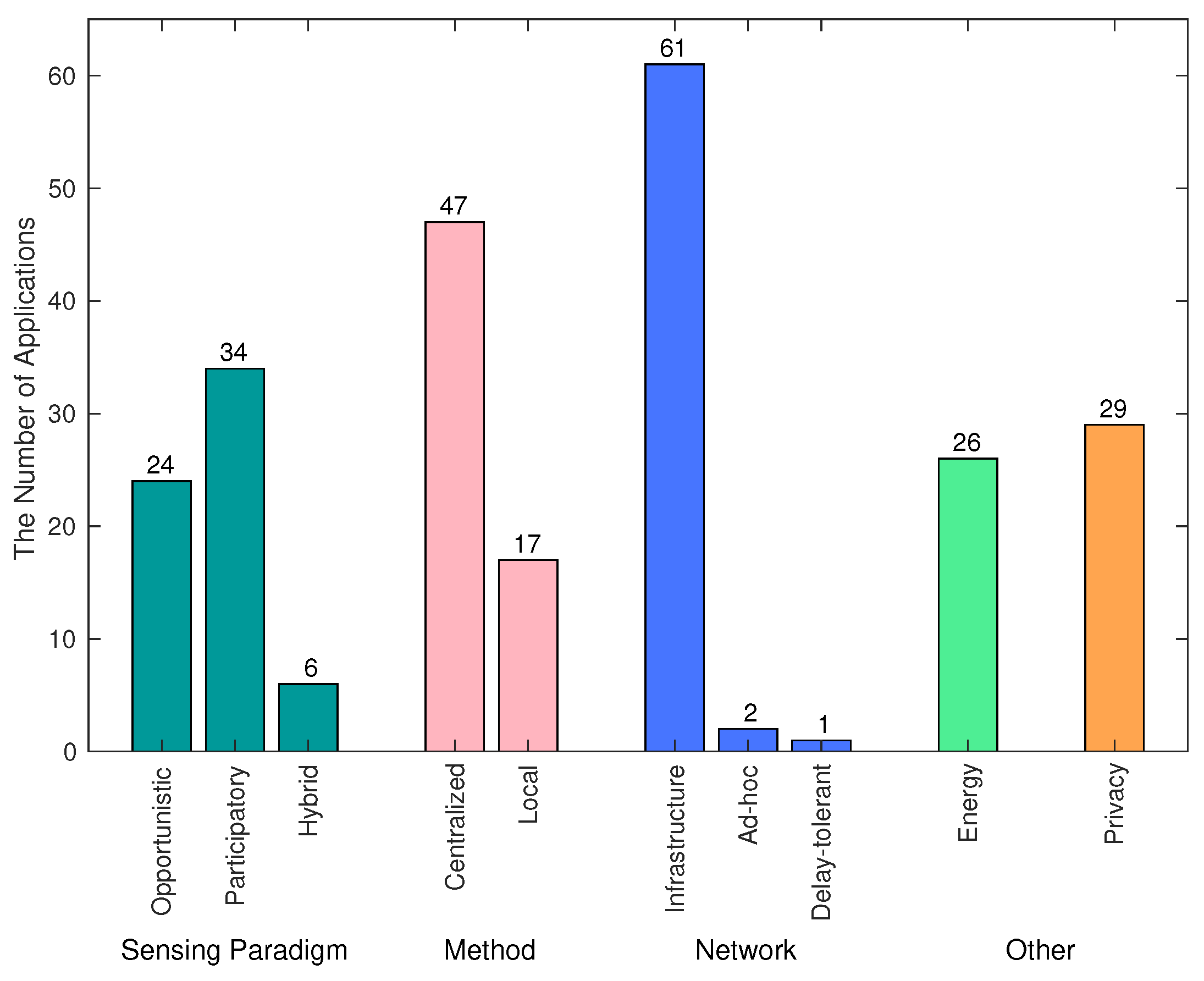
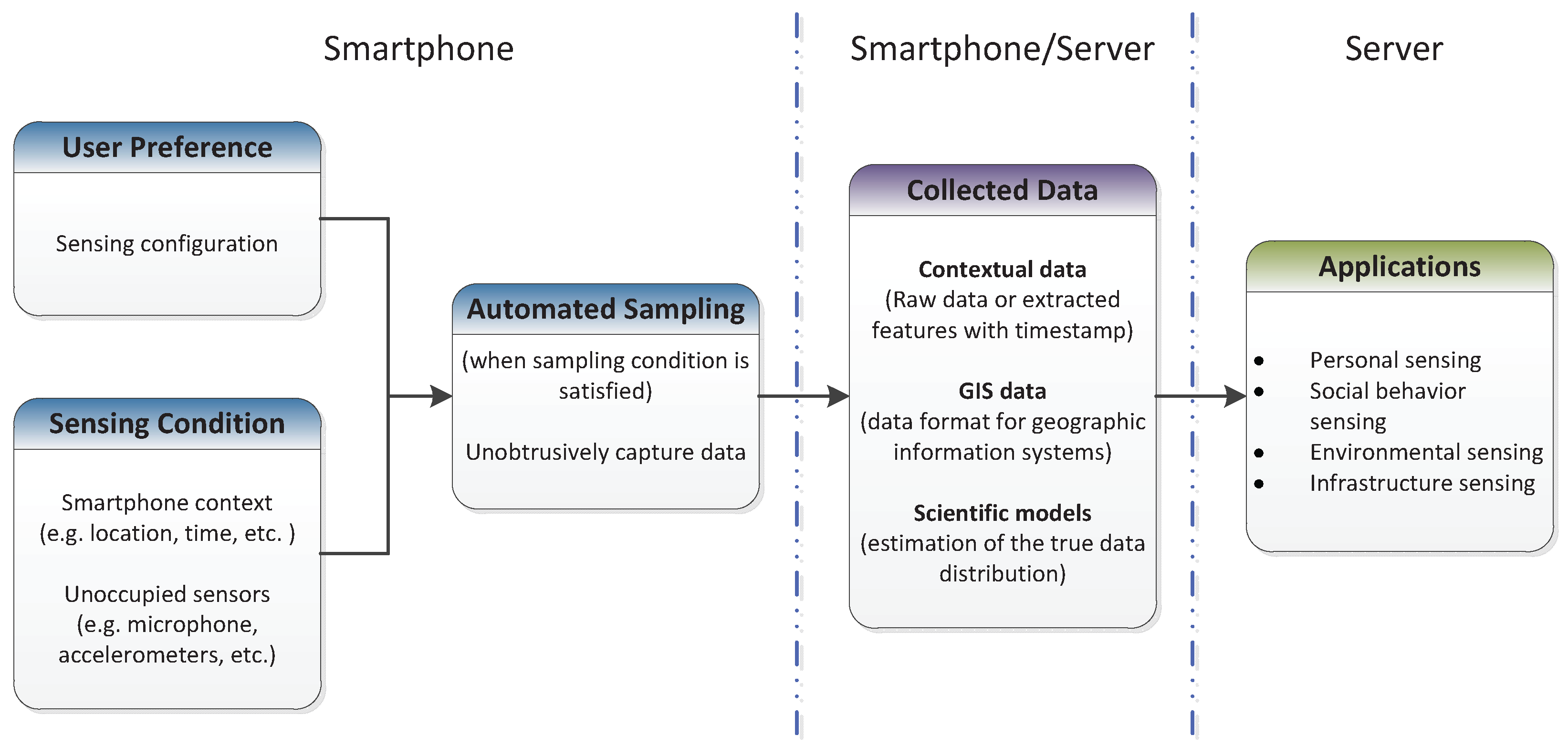
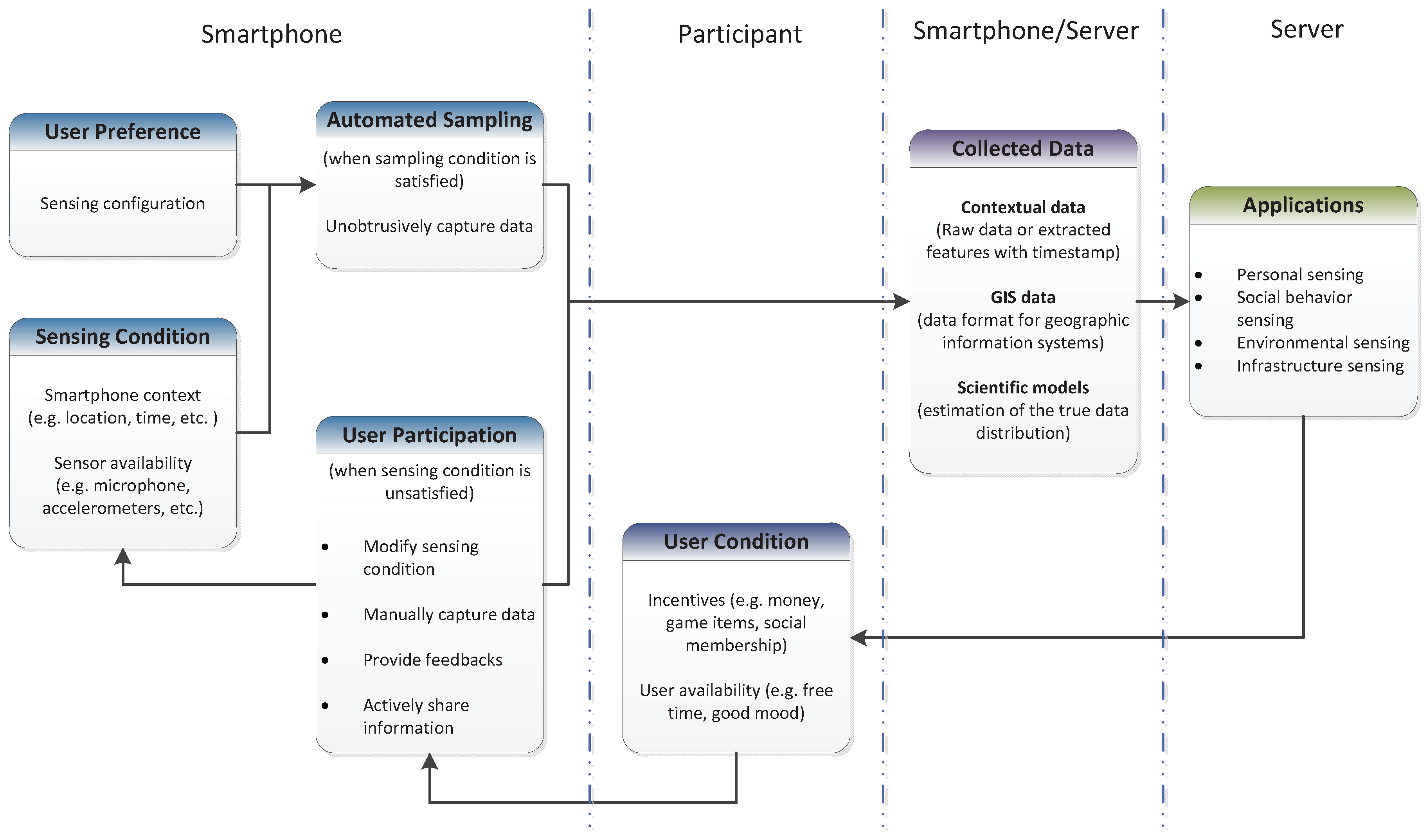
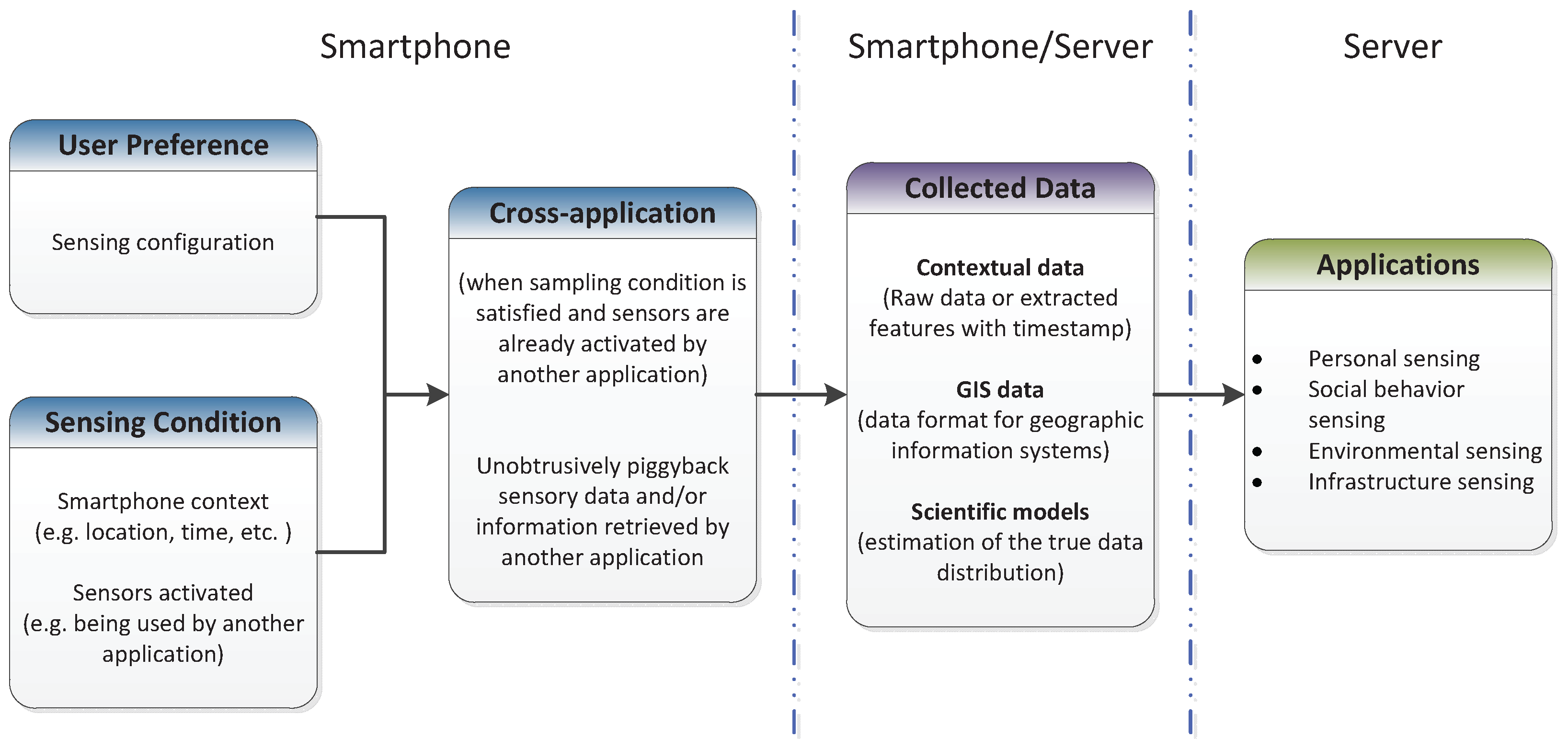
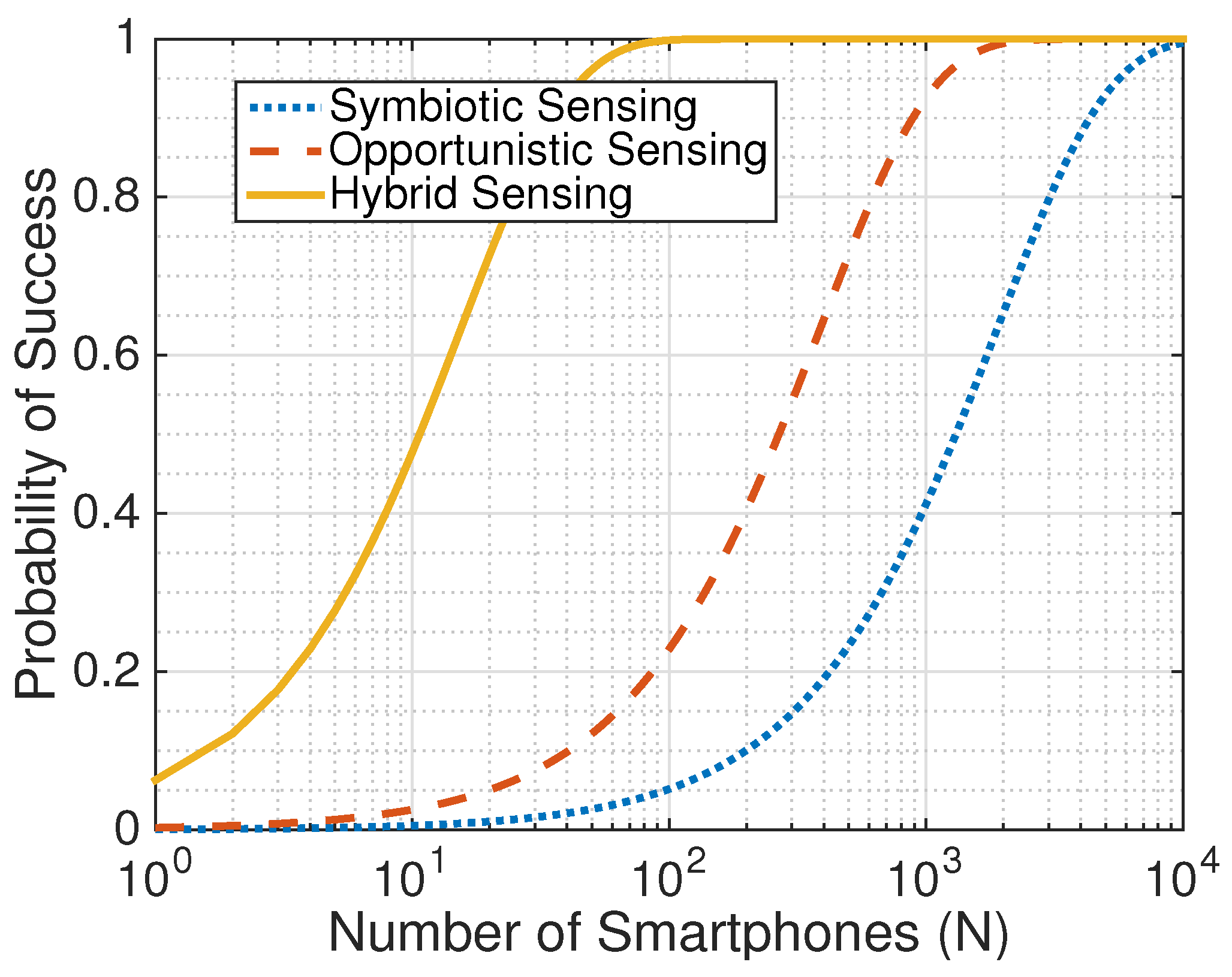

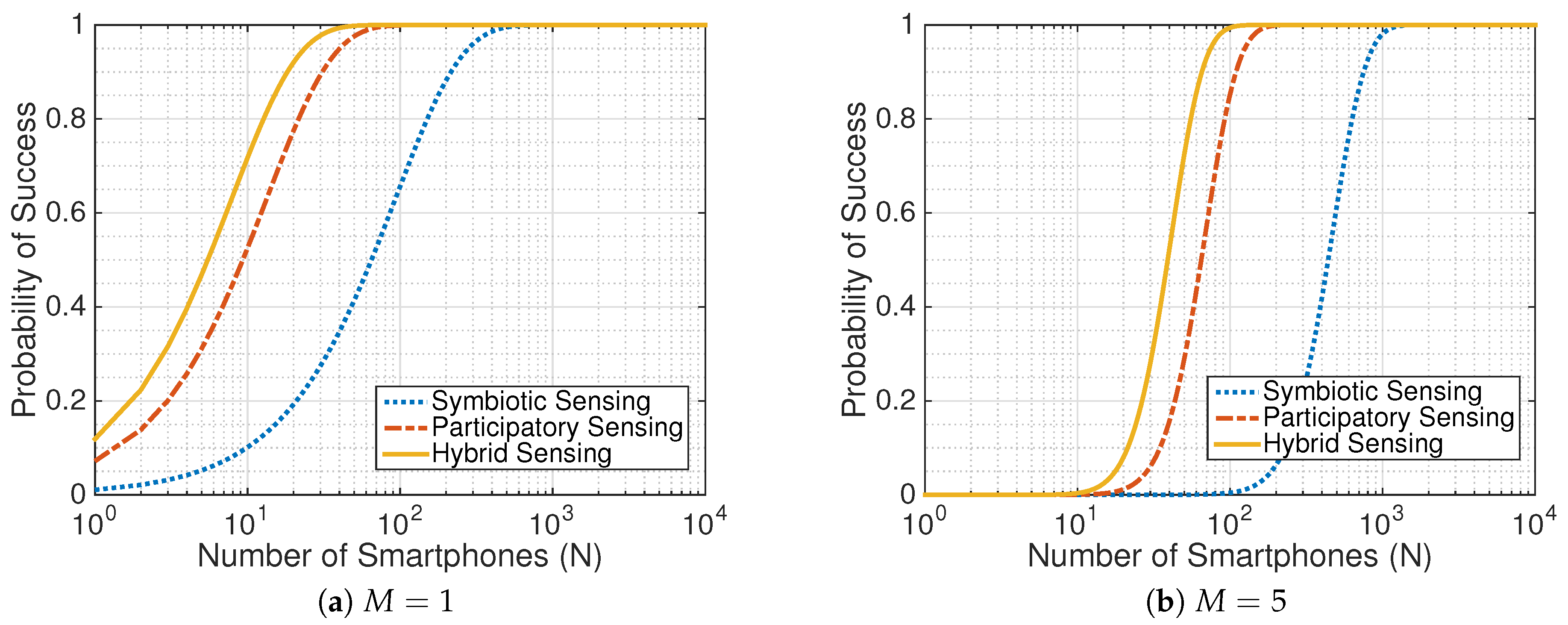
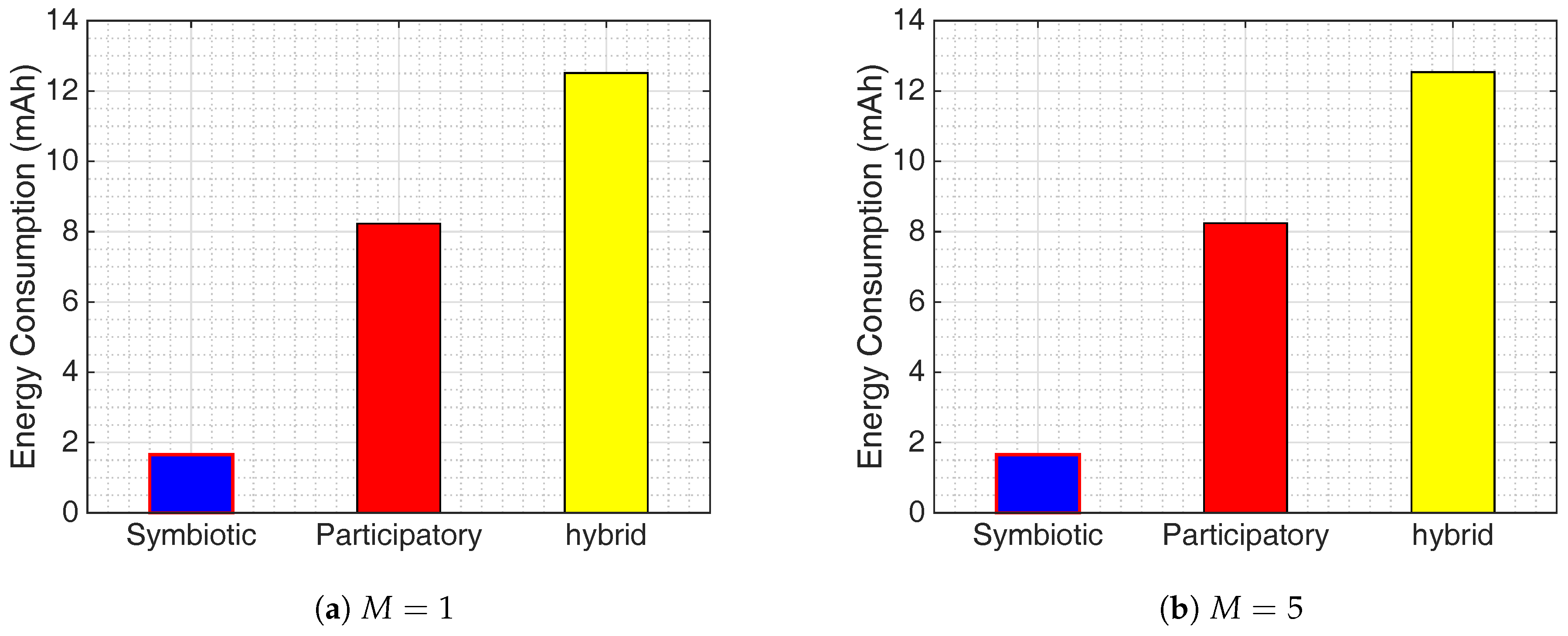
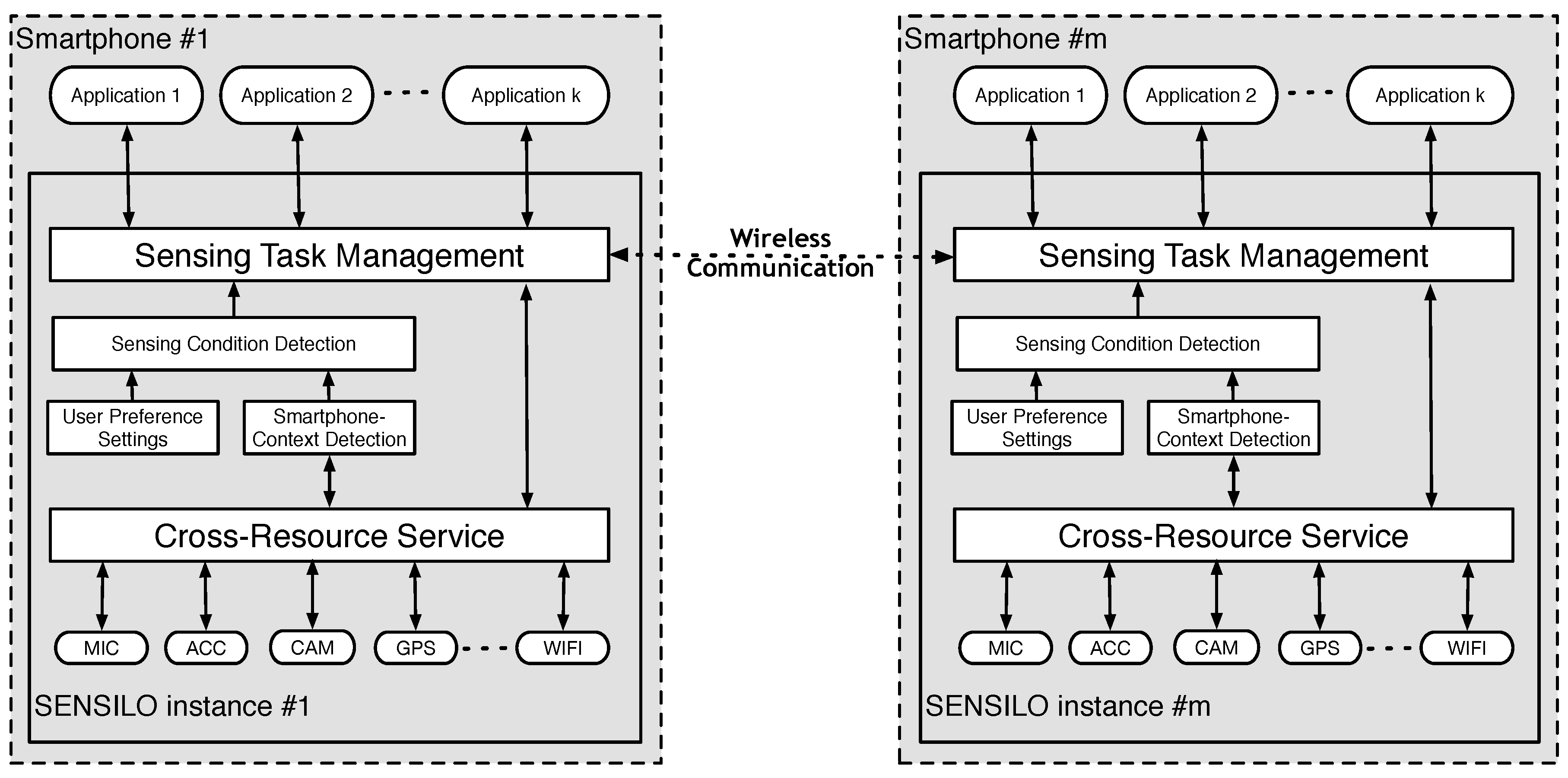
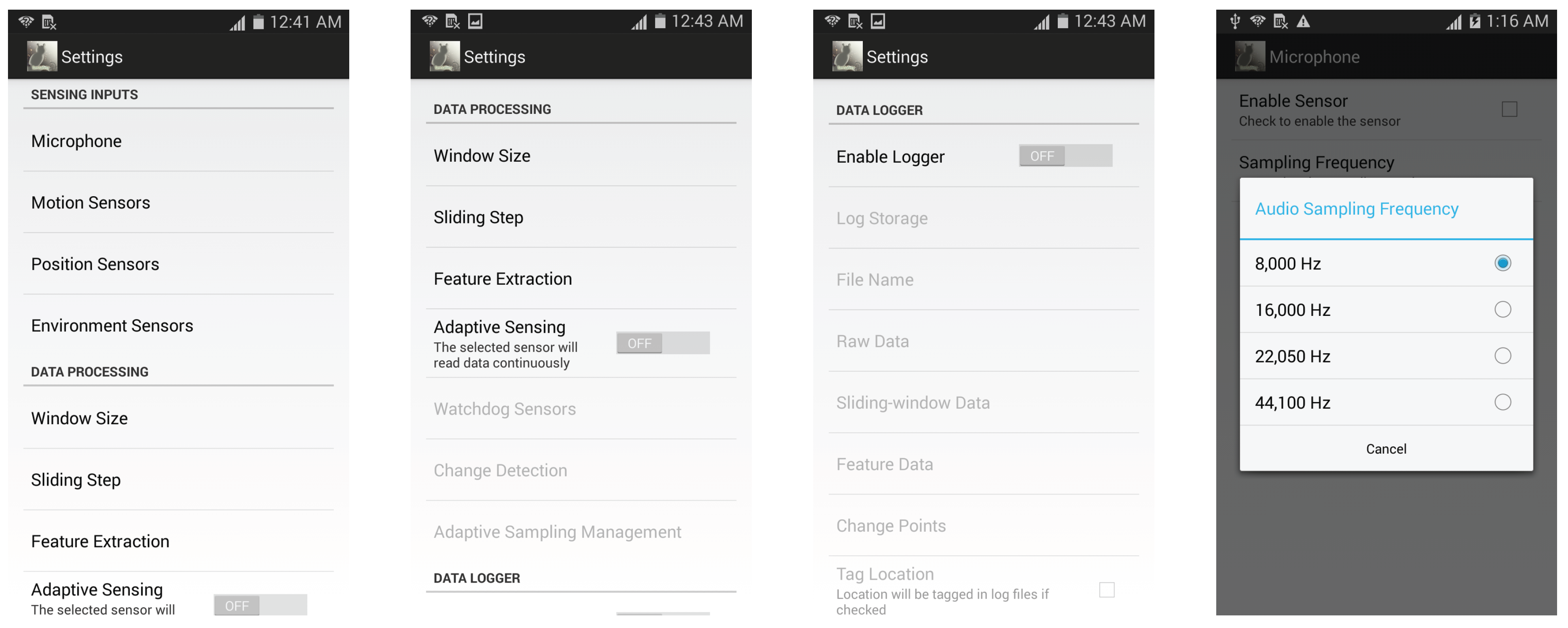
| Reference | Description | Application | Paradigm | Approach | Network | Energy | Privacy |
|---|---|---|---|---|---|---|---|
| DietSense [1] | Image Scape | Personal | Participatory | C | Infrastructure | No | Yes |
| PerFallD [2] | Fall Detection | Personal | Opportunistic | L | Infrastructure | Yes | Yes |
| HealthGear [3] | Sleep Monitoring | Personal | Opportunistic | L | Infrastructure | No | No |
| SociableSense [4] | Speaker Recognition | Personal | Opportunistic | L | Infrastructure | Yes | No |
| DarwinPhones [30] | Speaker Recognition | Personal | Opportunistic | L | Ad-hoc | Yes | Yes |
| EyePhone [31] | Eye-based Control | Personal | Participatory | L | Infrastructure | Yes | No |
| CONSORTSS [32] | Health Monitoring | Personal | Participatory | L | Infrastructure | No | No |
| SPA [33] | Health Monitoring | Personal | Participatory | C | Infrastructure | No | Yes |
| BALANCE [34] | Food Advice | Personal | Participatory | C | Infrastructure | No | No |
| UbiFit Garden [35] | Activity Advice | Personal | Participatory | L | Infrastructure | No | Yes |
| HyperFit [36] | Nutrion & Exercise | Personal | Participatory | C | Infrastructure | No | No |
| HealthAware [37] | Obesity Tackling | Personal | Participatory | L | Infrastructure | No | No |
| PACER [38] | Paper Reading | Personal | Participatory | C | Infrastructure | No | No |
| HeartToGo [39] | Cardiovascular | Personal | Opportunistic | C | Infrastructure | No | No |
| EmotionSense [40] | Speaking Recognition | Social Behavior | Opportunistic | L | Infrastructure | Yes | Yes |
| CenceMe [5] | Sport Analysis | Social Behavior | Participatory | C | Infrastructure | No | Yes |
| MoVi [6] | Video Highlights | Social Behavior | Participatory | C | Infrastructure | Yes | Yes |
| Party [7] | Party Detection | Social Behavior | Participatory | C | Infrastructure | Yes | Yes |
| Crowd Counting [8] | Crowd Density | Social Behavior | Opportunistic | L | Ad-hoc | Yes | Yes |
| Human Mobility [41] | Mobility Pattern | Social Behavior | Opportunistic | C | Infrastructure | No | Yes |
| Pedestrian Flocks [42] | Flock Detection | Social Behavior | Opportunistic | C | Infrastructure | No | No |
| WhozThat [43] | Indoor Localization | Social Behavior | Opportunistic | C | Infrastructure | No | Yes |
| Blueetooth Sensing [19] | Mobility and Interactions | Social Behavior | Participatory | C | Infrastructure | Yes | No |
| FlierMeet [44] | Public Information Sharing | Social Behavior | Participatory | C | Infrastructure | No | No |
| Laermometer [45] | City Noise Map | Environmental | Participatory | C | Infrastructure | No | No |
| PEIR [46] | Environment Impact | Environmental | Participatory | C | Infrastructure | No | Yes |
| EarPhone [47] | City Noise Map | Environmental | Participatory | C | Infrastructure | Yes | Yes |
| MicroBlog [48] | Micro Map | Environmental | Participatory | C | Infrastructure | Yes | No |
| SoundSense [49] | Music Detector | Environmental | Participatory | L | Infrastructure | Yes | Yes |
| Citizen Journalist [7] | Citizen Journalist | Environmental | Participatory | C | Infrastructure | Yes | Yes |
| MobGeoSen [50] | City Noise Map | Environmental | Participatory | L | Infrastructure | No | Yes |
| SmartDC [9] | Human Mobility | Environmental | Opportunistic | L | Infrastructure | Yes | No |
| DeepEar [10] | Environmental Sound | Environmental | Opportunistic | L | Infrastructure | Yes | No |
| CommonSense [11] | Air Monitoring | Environmental | Participatory | C | Infrastructure | No | No |
| MAQS [12] | Indoor Air Monitoring | Environmental | Opportunistic | C | Infrastructure | Yes | No |
| iSee [51] | Event Localization | Environmental | Participatory | C | Infrastructure | No | No |
| Crowdsourcing [24] | Incentive Design | Environmental | Participatory | C | Infrastructure | No | No |
| Visibility [52] | Air Visibility | Environmental | Participatory | C | Infrastructure | Yes | Yes |
| NoiseTube [53] | City Noise Map | Environmental | Hybrid | C | Infrastructure | No | Yes |
| PEIR [46] | Environment Impact | Environmental | Hybrid | C | Infrastructure | No | Yes |
| BikeNET [54] | Environment Impact | Environmental | Hybrid | C | Infrastructure | No | Yes |
| T-Shape [55] | Environment Impact | Environmental | Hybrid | C | Infrastructure | No | Yes |
| Bubble Sensing [56] | Environment Impact | Environmental | Hybrid | C | Infrastructure | No | Yes |
| UnLoc [57] | Indoor Localization | Environmental | Opportunistic | L | Infrastructure | No | No |
| 2Loud? [58] | City Noise Map | Environmental | Participatory | C | Infrastructure | No | Yes |
| Noise Monitoring [59] | City Noise Map | Environmental | Participatory | C | Infrastructure | Yes | Yes |
| Smart Cities [60] | City Noise Map | Environmental | Hybrid | C | Infrastructure | Yes | No |
| CarTel [61] | Driving Pattern | Transportation | Opportunistic | C | Delay-Tolerant | No | No |
| Refuelling Behavior [62] | Gas Station Placement | Transportation | Opportunistic | C | Infrastructure | No | No |
| GreenGPS [63] | Fuel Efficient Routes | Transportation | Participatory | C | Infrastructure | No | No |
| ParkNet [64] | Road-side Parking | Transportation | Opportunistic | C | Infrastructure | No | No |
| Travel Time [65] | Congestions Detection | Transportation | Opportunistic | C | Infrastructure | No | Yes |
| Bus Waiting [66] | Bus Arrival Prediction | Transportation | Participatory | C | Infrastructure | Yes | No |
| Railway Trip [67] | Passenger Congestion | Transportation | Opportunistic | C | Infrastructure | No | No |
| Crowd Density [68] | Crowd Density | Transportation | Opportunistic | C | Infrastructure | No | No |
| Pedestrian Flows [69] | Crowd Congestion | Transportation | Participatory | C | Infrastructure | Yes | No |
| VTrack [70] | Route Planning | Transportation | Participatory | C | Infrastructure | Yes | No |
| NeriCell [13] | Bump Detection | Transportation | Opportunistic | L | Infrastructure | Yes | Yes |
| Road Bump [7] | Bump Detection | Transportation | Opportunistic | C | Infrastructure | Yes | Yes |
| AnomySense [71] | Lost&Found | Transportation | Opportunistic | C | Infrastructure | Yes | Yes |
| SmartRoad [14] | Traffic Regulator Detection | Transportation | Participatory | C | Infrastructure | Yes | No |
| PublicSense [15] | Public Facility Management | Transportation | Participatory | C | Infrastructure | No | No |
| CrowdWatch [16] | Sidewalk Obstacle Detection | Transportation | Opportunistic | L | Infrastructure | No | No |
| Road Crack [72] | Road Crack Monitoring | Transportation | Participatory | C | Infrastructure | No | No |
© 2017 by the authors. Licensee MDPI, Basel, Switzerland. This article is an open access article distributed under the terms and conditions of the Creative Commons Attribution (CC BY) license (http://creativecommons.org/licenses/by/4.0/).
Share and Cite
Le, D.V.; Nguyen, T.; Scholten, H.; Havinga, P.J.M. Symbiotic Sensing for Energy-Intensive Tasks in Large-Scale Mobile Sensing Applications. Sensors 2017, 17, 2763. https://doi.org/10.3390/s17122763
Le DV, Nguyen T, Scholten H, Havinga PJM. Symbiotic Sensing for Energy-Intensive Tasks in Large-Scale Mobile Sensing Applications. Sensors. 2017; 17(12):2763. https://doi.org/10.3390/s17122763
Chicago/Turabian StyleLe, Duc V., Thuong Nguyen, Hans Scholten, and Paul J. M. Havinga. 2017. "Symbiotic Sensing for Energy-Intensive Tasks in Large-Scale Mobile Sensing Applications" Sensors 17, no. 12: 2763. https://doi.org/10.3390/s17122763





